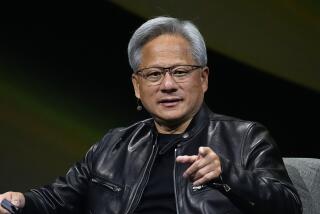Intel detects signs of bottom
- Share via
Semiconductor giant Intel Corp.’s first-quarter sales and profit tumbled, but the technology bellwether said Tuesday that the personal-computer market it dominates was finally stabilizing from a free fall that began last year as consumers zipped up their wallets and made do with the hardware they had.
Although the chip maker’s earnings fell 55% and revenue dropped 26%, both beat Wall Street’s estimates.
“We are seeing signs that the bottom of the PC market segment has been reached,” Intel Chief Executive Paul Otellini said during a conference call with analysts. “I believe the worst is now behind us.”
The Santa Clara, Calif., company earned $647 million, or 11 cents a share, on $7.1 billion in revenue in the quarter that ended March 28. A year earlier, it earned $1.4 billion, or 25 cents, on $9.7 billion in sales. Analysts predicted sales of just under $7 billion and net income of $157 million, or 3 cents a share.
Still, the report didn’t forecast the big turnaround that Wall Street had been hoping to hear from Intel as it kicked off the high-tech industry’s earnings season.
Investors have been betting that the high-tech sector has turned a corner, sending up Intel’s shares 8% this year compared with a 7% decline for the Standard & Poor’s 500 index. The company’s stock closed up 3 cents at $16.01 but declined more than 5% in after-hours trading after the earnings release.
“What Intel’s earnings [are] telling us is that things have gone from terrible to merely bad,” said David Wu, semiconductor analyst at Global Crown Capital. “People want to hear when things will get better. This doesn’t really tell us the answer.”
Laptop and desktop computers started to pile up in the fourth quarter as consumers and businesses put off buying them, so manufacturers stopped placing as many orders for Intel’s chips. The excess inventory was sold during the first three months of the year, and the company began to see “a gradual recovering of demand . . . and a return to more normal seasonal trends,” Otellini said.
But Intel warned that its profit margins were unlikely to improve in the current quarter because of the high cost of ramping up its newest chip factories and the shift toward consumer computers, which are less profitable than those sold to companies.
And though the PC market may have hit bottom, a recovery will probably be slow, analysts said.
“Intel put a cap on positive expectations for the second quarter,” said Patrick Wang, an analyst at Wedbush Morgan Securities. “If they had said they expect to grow revenue, the market would have rallied. Instead, they said revenue and margins will be flat, which is not a good way to start off the earnings season.”
Shipments of PCs are projected to grow just 0.7% in 2009, according to ISuppli Corp., a technology research firm. The El Segundo company predicts that an uptick in laptop computer sales will offset a continued decline in the number of desktops sold.
But the bargain-hunting mentality triggered by the recession means that manufacturers will have to cut prices, the firm predicted, translating to a 4% drop in total revenue to $192 billion this year from $201 billion in 2008.
One area of growth for Intel is the sale of so-called netbook computers, which are essentially lightweight laptops that cost $300 to $500. Sales of Intel’s Atom microprocessors, which power netbooks, were $219 million in the quarter.
Although that was down 27% from the prior quarter, “it’s revenue they didn’t have a year ago,” Wu said. “When you’re down this much, every little bit helps.”
--






